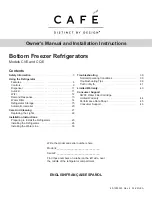
14
the cabinet during cleaning.
De-frosting the freezer compartment:
Once the build-up of ice has reached a thickness of 2-4 mm,
the freezer compartment must be de-frosted. It should be
cleaned at least twice a year as described below.
∙
Ensure that the plug has been removed from the wall
socket.
∙
Remove all food from the compartment and store it in a
cool location, eg together with pre-frozen freezer-packs
in a closed plastic container. Note that, even with a slight
increase in temperature, the storage life will be shortened
and the food should be used as soon as possible.
∙
Keep the door open. To accelerate defrosting, one or several
containers with hot (but not boiling) water may be placed
inside the freezer compartment.
∙
Warning:
do not use any external device or other means
(e.g. heaters or heating fans) to accelerate de-frosting.
∙
After cleaning, ensure that the freezer compartment is
thoroughly dry; set the temperature control to its maximum
position. After 24 hours, the temperature control can be set
back to its original position.
Defrosting the refrigerator cabinet
To ensure proper drainage of the melt-water, keep the drain
channel and discharge opening in the cabinet free from any
obstruction or blockage. A suitable pointed object can be used
for clearing or removing a blockage.
Energy saving tips
∙
The appliance should be set up in a well-ventilated, dry
room.
∙
Do not expose the appliance to direct sunlight, and do not
position it next to any heat sources (radiators, cookers etc.).
If this cannot be avoided, however, suitable insulation must be
installed between the heat source and the unit.
∙
Do not cover the ventilation openings and grilles, and ensure
suf
fi
cient air circulation behind the unit.
∙
The compressor (at the rear) should be cleaned at regular
intervals. Accumulated dust causes an increase in energy
consumption.
∙
Warm food should be allowed to cool down before it is
stored inside.
∙
To prevent an increased build-up of ice, do not leave the
doors of the unit open for too long when loading or taking
out food.
∙
Frequent de-frosting helps to save energy. For detailed
information on cleaning the appliance, please refer to the
section
De-frosting and cleaning
.
∙
Do not set a lower-than-necessary temperature. For detailed
information on the temperature settings, please refer to the
section
Temperature control
.
Trouble-shooting
Certain typical sounds can be heard when the appliance is
switched on. These sounds are caused by:
∙
the electric motor
within the compressor
assembly; during
compressor start-up
the sound level will be
slightly higher for a
limited period of time.
∙
the cooling agent
fl
owing through the circuit.
The following table lists possible malfunctions, their probable
causes and solutions. In the event of operational problems,
check
fi
rst whether a solution can be found using this table. If
the problem persists, disconnect the appliance from the mains
power and contact our Customer Service Department.
Problem
Possible cause and solution
The appliance is not working.
∙
There is a power failure
∙
The main fuse has blown.
∙
The temperature control is set to ‘
0
‘.
∙
The fuse in the wall socket (if applicable) has blown. This can be checked by connecting
another electrical device to the socket and checking for function.
The temperature inside the
freezer compartment is not low
enough.
∙
Too much food has been stored in the appliance.
∙
The doors are not properly closed.
∙
Insuf
fi
cient ventilation: the unit is too close to a wall or other structure or object.
The normal operating sound
changes or becomes louder.
∙
Check for proper positioning (uneven
fl
oor?).
∙
Are any adjacent objects affected by the running of the cooling unit (i.e. caused to vibrate?)
∙
Are there any objects on top of the unit which might be vibrating?
Water is collecting on the bottom
of the unit.
The melt-water drain system is blocked. Remove the blockage and clean the system.
Summary of Contents for KS 9893
Page 69: ...69 R600a GR...
Page 70: ...70 C5 H10 R600a 8 2 1 2 3 4 5 6 7...
Page 71: ...71 8 9 10 30 30 4 70 160 5 cm 10 cm 1 11 10 2 9 8 3 6 5 4 5 7 6 1 2 7 4 8 2 1 9 10 5 6...
Page 72: ...72 11 12 9 8 13 10 11 9 14 30 3 5 0 15 W E14 3 5 2 Max 24 10...
Page 73: ...73 4 1 4 4 7 3 4 5 2 4 24...
Page 74: ...74 0 30 30 30 4...
Page 75: ...75 KS KS 9893 A kWh 165 86 10 12 24 2 N ST C 16 38 C 43 dB a x x mm 847 x 494 x 494 25...
Page 76: ...76 R600a RU...
Page 77: ...77 C5 H10 R600a 8 2 1 2 3 4 5 6...
Page 78: ...78 7 8 9 10 30 30 4 70 160 5 10 1 11 10 2 9 8 3 6 5 4...
Page 79: ...79 5 7 6 1 2 7 4 8 2 1 9 10 5 6 11 12 9 8 13 10 11 9 14 30 3 5 0 15 E14 3 5 2 Max 24...
Page 80: ...80 10 4 1 4 4 7 3 4 5 2 4 24...
Page 81: ...81 0 30 30 30...















































